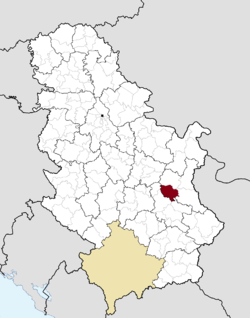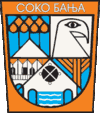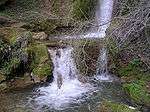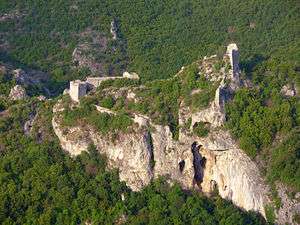Sokobanja
| Sokobanja Сокобања | ||
|---|---|---|
|
| ||
| ||
 Location of the municipality of Sokobanja within Serbia | ||
| Coordinates: 43°39′N 21°52′E / 43.650°N 21.867°ECoordinates: 43°39′N 21°52′E / 43.650°N 21.867°E | ||
| Country |
| |
| Region | Southern and Eastern Serbia | |
| District | Zaječar | |
| Settlements | 25 | |
| Government | ||
| • Mayor | Isidor Krstić | |
| Area[1] | ||
| • Municipality | 525 km2 (203 sq mi) | |
| Elevation | 369 m (1,211 ft) | |
| Population (2011 census)[2] | ||
| • Town | 7,982 | |
| • Municipality | 16,021 | |
| Time zone | UTC+1 (CET) | |
| • Summer (DST) | UTC+2 (CEST) | |
| Postal code | 18230 | |
| Area code | +381(0)18 | |
| Car plates | ZA | |
| Website |
www | |
| Historical population | ||
|---|---|---|
| Year | Pop. | ±% p.a. |
| 1948 | 23,733 | — |
| 1953 | 24,621 | +0.74% |
| 1961 | 24,285 | −0.17% |
| 1971 | 23,932 | −0.15% |
| 1981 | 23,394 | −0.23% |
| 1991 | 21,948 | −0.64% |
| 2002 | 18,571 | −1.51% |
| 2011 | 16,021 | −1.63% |
| 2016 est. | 14,755 | −1.63% |
| Source: [3][4] | ||
Sokobanja (Serbian Cyrillic: Сокобања, pronounced [sɔ̂kɔbaɲa]) is a spa town and municipality located in the Zaječar District of the eastern Serbia. As of 2011, the population of the town is 7,982, while population of the municipality is 16,021.
Geography
Sokobanja is one of the most popular tourist resorts in Serbia. It is situated in the southern part of Sokobanja valley, surrounded by mountains Ozren, Devica, Janior, Rtanj and Bukovik. The Moravica River runs through Sokobanja. It creates a canyon just 2 km before entering the town. Remains of the Roman and later medieval Serbian fortress Sokograd stand today near the canyon of Moravica.
The Moravica was known for the clear water and the abundance of the crayfish. The 1945 edition of the Politika newspaper reports about the export of the crayfish from Sokobanja, stating that "they were transported from Moravica by airplanes to Paris, London and Monte Carlo".[5] Artificial Lake Bovan on the Moravica is situated some 10 minutes drive to the west of Sokobanja.
History
Soko Grad
Soko Grad (Соко Град), also known as Sokolac, was a medieval city and fortress 2 km (1.2 mi) east of Sokobanja. The fortress was declared a Monument of Culture of Great Importance in 1982, and it is protected by Republic of Serbia.[6]
The fortress originates from the Roman, early Christian period.[5] It was founded in the 6th century during the reign of Emperor Justinian I, to prevent incursions of Pannonian Avars and Slavs into the Balkan peninsula. In 1172, it was occupied by Stefan Nemanja and became part of the medieval Serbian state. There are evidence that the fortress was razed during the Stefan Nemanja's rule, as part of the prosecution of the Bogumils.[5]
The fort was rebuilt and expanded in the late 13th and early 14th centuries on the foundations of the Roman fort. It was mentioned later during the reign of Despot Stefan Lazarević. The Ottoman Empire occupied it in 1398. The town was destroyed in 1413 by the Ottomans during the 1402-13 civil war, in the battle between Musa Çelebi and the local Turkish chieftain Hamuz Beg.[5] Today the only visible remains of the upper town are the gate, walls, and three towers.
In the village of Vrmdža, 12 km (7.5 mi) to the north, there are remains of another fort, Town of Vrmdža Vrmdžanski grad. It was also originally a Roman fortress built during the rule of Emperor Justinian I and was also destroyed in 1413.[5]
Tourism
Sokobanja, as both the thermal and air spa, is one of the most popular tourist resorts in Serbia.[5]
Satirist Branislav Nušić coined the rhyme Soko-banja, Soko-grad, dođeš mator, odeš mlad ("Soko-spa, Soko-town, you come old, you leave young"). He wrote it on a postcard manufactured by his friend, so that he could boost the sales. After being printed in the Politika newspaper on 7 July 1934, the catchphrase became popular, surviving till today as the trademark of Sokobanja, inspiring several songs.[5]
Spa
There are remains of the Roman thermae: wooden foundations, bricks, mosaics and round bathtubs. During the Ottoman period, the Roman foundations were used for the Turkish bath in the 16th century. The Turks kept the original round shape of the pools as in the hamams they are usually square-shaped. Aboce each pool there is a dome with holes which function as the natural ventilation.[5]
In 1834, Serbian ruling prince Miloš Obrenović ordered for the mineral waters from Sokobanja to be sent to Vienna, Austria, for testing which confirmed the positive healing effect of the water. In 1835, on prince's invitation, German geologist August von Herder among other thermal springs and mining localities, visited Sokobanja. He compared its waters to those from the Austrian spa Bad Gastein.[5]
On 21 June 1837, Prince Miloš signed an order for a sergeant major Lazarević from the Military-police office in Kragujevac to be sent to Sokobanja for a healing treatment. This date is today considered as the starting date of the spa tourism in Serbia. Prince renovated and expanded the Turkish bath and appointed Austrian doctor Leopold Ehrlich as the first spa doctor. Prince personally visited spa a lot and built several other objects, like the Prince Miloš Fountain, on the road to Aleksinac, Miloš' Konak in downtown Sokobanja, today a restaurant, and Miloš' bathtub in the hamam. The prince's bathtub, which still in use today just as the entire hamam complex, is short but deep, has its own tap and is placed in a separate room. There are two other pools, "male" and "female", with hot water from the underground springs.[5]
The spa became quite popular among the cultural elite. Apart for Nušić, it was visited by Jovan Cvijić, Isidora Sekulić, Stevan Sremac and Meša Selimović, while the Nobelist author Ivo Andrić draw a graphic of the town.[5]
The Turkish bath in Sokobanja is the only still functioning such facility in the eastern Serbia. Under the name Staro banwsko kupatilo ("Old spa bath") it is protected by the state and declared a cultural monument. It is colloquially also called Roman bath or Turkish bath-Amam. The venue served as the setting for the "Serbian box office wonder", film Zona Zamfirova in 2002. The bath was renovated in 2005.[5]
Other
Other attractions include swimming in the Moravica river and the Lake Bovan, which is especially popular among fishermen, galleries, museums, various concerts and festivities, hiking, wellness centers, hotels, aqua park, saunas, etc. Festivals include "Saint John the Herbs-picker" (in July; dedicated to the medicinal herbs picking on the surrounding mountains of Ozren, Rtanj and Devica), "Green Heart Fest" (in July; the rock and house music festival) and "Marathon of the wishes" (in September). Since 1983, a "Golden hands" cooking festival has been held annually in July. Only the old, traditional local meals are prepared. Hiking is organized on the Ozren, Rtanj, Devica and Bukovik mountains, while the popular excursion sites are the Sesalac cave, Očno, Kalinovica and Lepterija, known for the natural phenomenon, an apparent image of the Mother of God in the boulder.[5]
In the neighborhood of Gradašnica, on the river of the same name, there were 13 watermills, built from the early 19th century. They all went out of service by the 1960s. One of them has been renovated and became operational again, but only for the touristic purposes so that visitors can grind the cereals and knead dough themselves. On the ozren mountain there is a large, single boulder in the middle of the vast meadow. It has been called the "Stone of love" as, allegedly, those who exchange kisses of vows sitting on the rock, will stay together forever. According to the folk story, military commander and rebel Hajduk-Veljko and female hajduk Čučuk Stana, exchanged vows at this location.[5]
A special hospitals for lung diseases and ophthalmology are situated on Ozren mountain, surrounded by the forest.[5] The town center of Sokobanja is home to the 19th-century buildings of elementary school and Serbian Orthodox church.
In the village of Jošanica, 15 km (9.3 mi) to the northwest, there is a Church of the Dormition of the Mother of God. Founded in the 11th century, it is the oldest existing church in eastern Serbia. Closer to Sokobanja, on the Ozren mountain, there is a Jermenčić Monastery, founded in the 14th century by the Armenians who were fleeing the invading Ottomans. Southeast of Sokobanja, on the slopes of Ozren, there is a seasonal Ripaljka waterfall. It exists only during the spring, after the snow melts on the mountain. Already by May, it is usually dry.[5]
Population
According to 2011 census of population, there were 16,021 inhabitants in the municipality and 7,982 in the town and municipal seat. The area has been depopulating for decades. The number of inhabitants in the municipality peaked in 1953 (pop. 24,621), while the largest population in the town was recorded in 1991 (pop. 8,439).[2]
Settlements
Aside from the town of Sokobanja, the municipality is consisted of the following villages (2011 population):[2]
|
|
|
|
|
Gallery
|
See also
References
- ↑ "Municipalities of Serbia, 2006". Statistical Office of Serbia. Retrieved 2010-11-28.
- 1 2 3 "2011 Census of Population, Households and Dwellings in the Republic of Serbia: Comparative Overview of the Number of Population in 1948, 1953, 1961, 1971, 1981, 1991, 2002 and 2011, Data by settlements" (PDF). Statistical Office of Republic Of Serbia, Belgrade. 2014. ISBN 978-86-6161-109-4. Retrieved 2014-06-27.
- ↑ Comparative overview of the number of population in 1948, 1953, 1961, 1971, 1981, 1991, 2002 and 2011 – Data by settlements, page 29. Statistical Office of the Republic of Serbia, Belgrade. 2014. ISBN 978-86-6161-109-4.
- ↑ Thomas Brinkhoff: City Population, Serbia: Administrative Division, Districts and Municipalities
- 1 2 3 4 5 6 7 8 9 10 11 12 13 14 15 16 Aleksandra Mijalković (29 April 2018). "Sokobanjska razglednica" [Postcard of Sokobanja]. Politika-Magazin, No. 1074 (in Serbian). pp. 19–21.
- ↑ Monuments of Culture in Serbia: СОКО ГРАД (SANU) (in Serbian) (in English)
External links
| Wikimedia Commons has media related to Sokobanja. |



